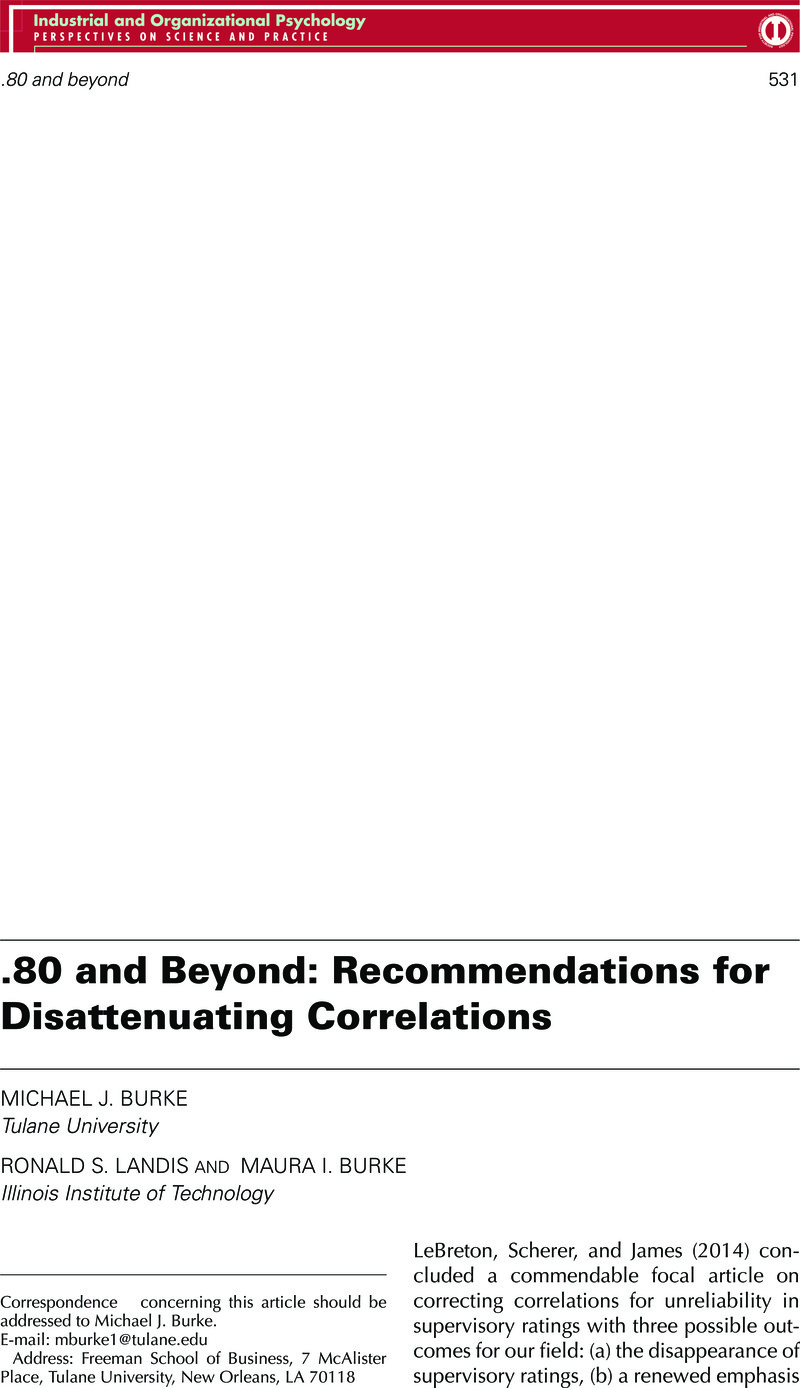No CrossRef data available.
Article contents
.80 and Beyond: Recommendations for Disattenuating Correlations
Published online by Cambridge University Press: 10 April 2015
Abstract
An abstract is not available for this content so a preview has been provided. Please use the Get access link above for information on how to access this content.

- Type
- Commentaries
- Information
- Copyright
- Copyright © Society for Industrial and Organizational Psychology 2014
References
Bing, M. N., Davison, H. K., Minor, I., Novicevic, M. M., & Frink, D. D. (2011). The prediction of task and contextual performance by political skill: A meta-analysis and moderator test. Journal of Vocational Behavior, 79, 563–577.Google Scholar
Burke, M. J., & Dunlap, W. P. (2002). Estimating interrater agreement with the average deviation index: A user's guide. Organizational Research Methods, 5, 159–172.Google Scholar
Burke, M. J., & Landis, R. (2003). Methodological and conceptual issues in applications of meta-analysis. In Murphy, K. (Ed.), Validity generalization: A critical review (pp. 287–310). Hillsdale, NJ: Lawrence Erlbaum.Google Scholar
Burke, M. I., Landis, R., & Burke, M. J. (2014, May). Conducting meta-analysis at the group-level of analysis. In S. B. Morris (Chair), Meta-analysis methods for messy, incomplete, and complex data. Symposium at the 29th Annual Conference of the Society for Industrial and Organizational Psychology, Honolulu, HI.Google Scholar
Burke, M. J., Salvador, R., Smith-Crowe, K., Chan-Serafin, S., Smith, A., & Sonesh, S. (2011). How workplace hazards and training influence learning and performance. Journal of Applied Psychology, 96, 46–70.Google Scholar
Burke, M. J., Sarpy, S. A., Smith-Crowe, K., Chan-Serafin, S., Islam, G., & Salvador, R. (2006). Relative effectiveness of safety and health training methods. American Journal of Public Health, 96, 315–324.Google Scholar
Christian, M. S., Garza, A. S., & Slaughter, J. E. (2011). Work engagement: A quantitative review and test of its relations with task and contextual performance. Personnel Psychology, 64, 89–136.Google Scholar
Harter, J. K., Schmidt, F. L., Asplund, J. W., Killham, E. A., & Agrawal, S. (2010). Causal impact of employee work perceptions on the bottom line of organizations. Perspectives on Psychological Science, 5(4), 378–389.CrossRefGoogle ScholarPubMed
Hong, Y., Liao, H., Hu, J., & Jiang, K. (2013). Missing link in the service profit chain: A meta-analytic review of the antecedents, consequences, and moderators of service climate. Journal of Applied Psychology, 98(2), 237–267.Google Scholar
Landy, F. J., & Farr, J. L. (1980). Performance rating. Psychological Bulletin, 87, 72–107.Google Scholar
Lang, J. W. B., Kersting, M., Hulsheger, U. R., & Lang, J. (2010). General mental ability, narrower cognitive abilities, and job performance: The perspective of the nested factors model of cognitive abilities. Personnel Psychology, 63, 595–640.CrossRefGoogle Scholar
LeBreton, J. M., Scherer, K. T., & James, L. R. (2014). Corrections for criterion reliability in validity generalization: A false prophet in a land of suspended judgment. Industrial and Organizational Psychology: Perspectives on Science and Practice, 7(4), 478–500.Google Scholar
Lord, F. M., & Novick, M. R. (1968). Statistical theories of mental test scores. Reading, MA: Addison-Wesley.Google Scholar
Raju, N. S., & Brand, P. A. (2003). Determining the significance of correlations corrected for unreliability and range restriction. Applied Psychological Measurement, 27, 52–71.Google Scholar
Raju, N. S., Burke, M. J., Normand, J., & Langlois, G. (1991). A new meta-analytic approach. Journal of Applied Psychology, 76, 432–446.Google Scholar
Wallace, J. C., Edwards, B. D., Paul, J., Burke, M. J., Christian, M., & Eissa, G. (2013). Change the referent? A meta-analytic investigation of direct and referent-shift consensus models for organizational climate. Journal of Management, 39, 1156–1183.Google Scholar
Whitman, D. S., Caleo, S., Carpenter, N. C., Horner, M. T., & Bernerth, J. B. (2012). Fairness at the collective level: A meta-analytic examination of the consequences and boundary conditions of organizational justice climate. Journal of Applied Psychology, 97(4), 776–791.Google Scholar
Whitman, D. S., Van Rooy, D. L., & Viswesvaran, C. (2010). Satisfaction, citizenship behaviors, and performance in work units: A meta-analysis of collective construct relations. Personnel Psychology, 63(1), 41–81.Google Scholar
Wildman, J. L., Bedwell, W. L., Salas, E., & Smith-Jentsch, K. A. (2011). Performance measurement at work: A multilevel perspective. In Zedeck, S. (Ed.), APA handbook of industrial and organizational psychology: Volume 1 building and developing the organization (pp. 303–341). Washington, DC: American Psychological Association.Google Scholar




